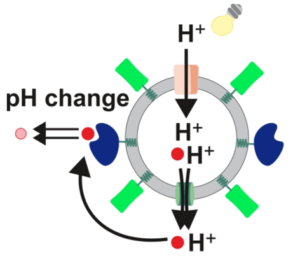Project P1
P1: Nanodevices for MC-Based Sensing and Control in Microliter-scale Bioreactors
Motivation and state of the art:
Miniaturized bioreactors serve the purpose of enabling process developments in higher throughput under process-relevant conditions. Commercially available scale-down devices typically operate at the milliliter-scale (1-15 mL) and are equipped with liquid handling systems, such as pipetting robots, to enable substrate feeding and pH regulation1-3. Solutions for even smaller volumes with integrated process control options are the domain of microfluidic concepts3,4 and have typical working volumes between 100 and 500 µL. However, they usually only allow pH regulation or substrate feeding, have insufficient pump rate stability resulting in non-reproducible dosing behavior, or use valves with large minimum dosing volumes5-8. Thus, an innovative bioprocess engineering tool that combines very small working volumes (<< 100 µL) with high-precision reaction control might have a major impact on the field of bioprocess miniaturization.
Objectives:
The goal of this project is to develop a modular toolbox of nanodevices for monitoring and controlling reaction conditions in microliter-scale bioreactors. The interaction of these nanodevices with their environment is based on communication between biological molecules, which not only function as (bio)sensors but also as active control elements. Key components of the devices are membrane transport proteins acting as high-precision pumps, whose naturally inherent transport accuracy is unattainable with man-made machines. These proteins are inserted into nano-scale polymer vesicles, so-called polymersomes. For reaction control comparable to liter-scale reactors, nanodevices for pH control and substrate feeding will be developed. These modules are powered either directly or indirectly (via adenosine triphosphate (ATP)) by the proton-motive force generated by light-driven proton pumps. The communication-theoretical model of the end-to-end control processes developed in P3 facilitates the fine-tuning of the ratios of the protein components for optimal nanodevice performance. P2 investigates alternative proteins to further improve the sensing and transport processes.
References
1.L. Bromig, N. von den Eichen, and D. Weuster-Botz D. “Control of Parallized Bioreactors I: Dynamic Scheduling Software for Efficient Bioprocess Management in High-throughput Systems,” Bioproc. Biosys. Eng., vol. 45, pp. 1927-1937, Oct. 2022, doi: 10.1007/s00449-022-02798-6.
2.M. Bournazou, T. Barz, D. Nickel, D. Cardenas, F. Glauche, A. Knepper, and P. Neubauer, “ Online Optimal Experimental Re-design in Robotic Parallel Fed-batch Cultivation Facilities,” Biotechnol. Bioeng., vol. 114, pp. 610-619, Mar. 2017, doi.org/10.1002/bit.26192.
3.T. Ladner, A. Grünberger, C. Probst, D. Kohlheyer, J. Büchs, and F. Delvigne. “15- Application of Mini- and Micro-Bioreactors for Microbial Bioprocesses,“ in Current Develop. Biotechnol. Bioeng., Eds. C. Larroche, M. Sanromán, G. Du, and A. Pandey (Amsterdam: Elsevier), pp. 433–461, 2017, doi: 10.1016/B978-0-444-63663-8.00015-X.
4.M. Marques and N. Szita. “Bioprocess Microfluidics: Applying Microfluidic Devices for Bioprocessing,” Curr. Opin. Chem. Eng., vol. 18, pp. 61-68, Nov. 2017, doi: 10.1016/j.coche.2017.09.004.
5.M. Funke, A. Buchenauer, W. Mokwa, S. Kluge, L. Hein, C. Müller, F. Kensy, and J. Büchs. “Bioprocess Control in Microscale: Scalable Fermentations in Disposable and User-friendly Microfluidic Systems,” Microb. Cell. Fact., vol. 9, article no. 86, Jul. 2010, doi: 10.1186/1475-2859-9-86.
6.T. Kirk and N. Szita, “Oxygen Transfer Characteristics of Miniaturized Bioreactor Systems,” Biotechnol. Bioeng., vol. 110, pp. 1005-1019, Jan. 2017.
7.H. Lee, P. Boccazzi, R. Ram, and A. Sinskey, “Microbioreactor Arrays with Integrated Mixers and Fluid Injectors for High-throughput Experimentation With pH and Dissolved Oxygen Control,” Lab Chip, vol. 6, pp. 1229-1235, Jul. 2006.
8.P. Gruber, M. Marques, P. Sulzer, R. Wohlgemuth, T. Mayr, F. Baganz, and N. Szita, “Real-time pH Monitoring of Industrially Relevant Enzymatic Reactions in a Microfluidic Side-entry Reactor (SER) Shows Potential for pH Control.” Biotechnol. J., vol. 12, 1600475, Jun. 2017, doi: 10.1002/biot.201600475.

